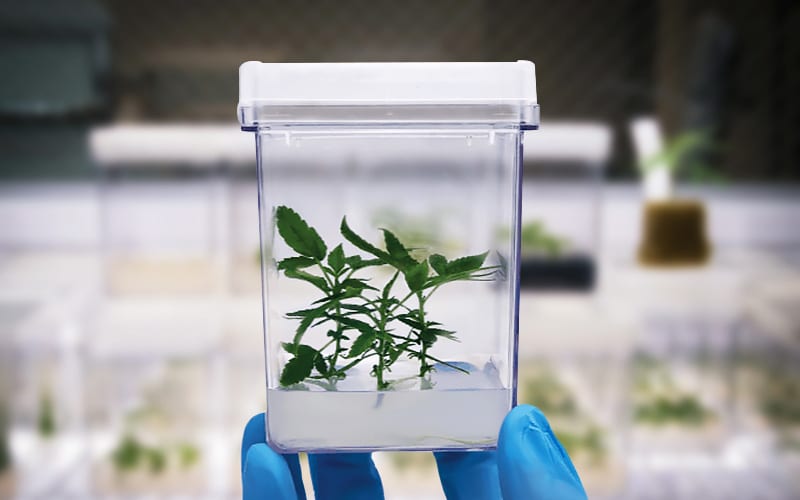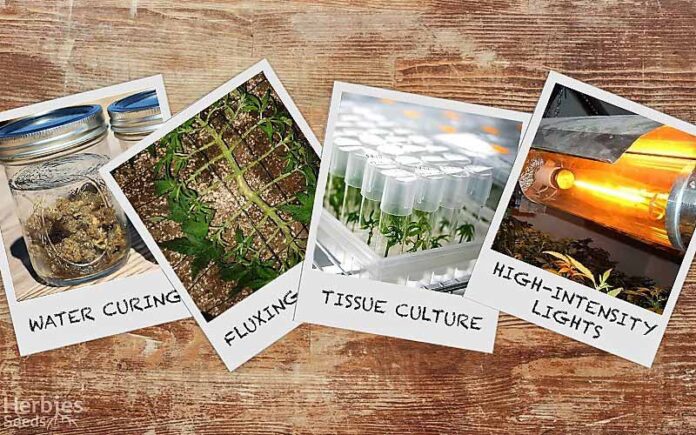Recent cannabis legalization in certain places has paved the way for increased scientific research into cannabis-related technology. This has led to modernization within the industry, and we are now seeing some interesting trends in cannabis cultivation.
In this article, we will examine some of these cannabis growing trends in a little more detail. We’ll look at the future of cloning and indoor lighting, touch upon an advanced training method, and round off with a trendy curing technique.
Tissue Culture For Superior Clones

Tissue culture – known technically as micropropagation – has been around for well over a hundred years but has only just started trending in the cannabis industry. It refers to an advanced technique for cloning plants that’s suitable for both large businesses and home growers who value genetics, high yields, and quality above all else.
This form of cloning occurs in a sterile environment where a small sample is taken from the mother plant. The sample undergoes a sterilization process and is then placed into a specially formulated tissue culture gel that contains nutrients, hormones, and sugars.
The grower can keep plant cells alive without triggering growth. To trigger vegetative growth and root development, the grower simply needs to introduce new hormones and nutrients. Once the sample reaches a high enough level of development, it can be used to produce additional clones.
This method is gaining traction as it produces genetically identical plants to the mother without carrying on any genetic mutations or infections. It’s also more productive over time – one tiny sample can end up producing thousands of identical copies – and can save you a great deal of physical space. Tissue culture kits are now available online for home growers to conduct their own micropropagation experiments.
High-Intensity Lights For Larger Yields
Ask two different growers about the best lights for growing cannabis and you can expect two different answers. High-pressure sodium (HPS) lighting has long been considered the optimum source of light, although many swear by their light-emitting diodes (LEDs) or high-intensity discharge (HID) setups.
These lighting systems have been specifically designed for horticulture, and as such, they’re expensive. However, thanks to a recent 2019 study completed by Greenseal Cannabis Company, we now have a more budget-friendly option.
Researchers analysed how increasing the intensity of light affected crop yields, and they found that outputs increased linearly up to 1,500 micromoles per square meter (umol/m2). This was an unexpectedly high number, as it was “at least twice the intensity that is most commonly used by cannabis growers.” The lighting came from a high-intensity broad spectrum (white) light; a much cheaper alternative to the aforementioned commercial lighting options.
The study also took into account the extra electricity required to power these lights. Yields increased by 0.41 grams per umol/m2, meaning that the extra value of cannabis from the higher yields far exceeded the extra money spent on power. This method is therefore invaluable for those looking to increase yields with a budget-friendly grow setup.
Fluxing for Big Yields In Small Spaces

Fluxing refers to the advanced training method first coined by the grower ‘Light Addict,’ and it’s an excellent method for those who have a limited amount of space to work with. The full thread can be found here at 420 Magazine. It involves a complete manipulation of growth that results in an amazing grid-style pattern, ensuring big yields in small spaces (while looking seriously impressive at the same time).
To implement this method, your seedling will need to have grown the third node. Once well-established, it can be topped. The top two heads should be trained into linear horizontal growth so that your plant takes on the shape of an elongated ‘T’.
As new heads form on the main stem, train them out at right angles. If too many heads form and it becomes unmanageable, simply remove them. Remove any new shoots on the heads that you’ve decided to keep, as you only want one big bud per branch.
Once the branches are long enough, you can bend a few of them inward to fill up space toward the middle of the plant. When you’re happy with how everything is formed, it’s time for some vertical growth, using low-stress training to promote a uniform canopy.
Water Curing For Smoother & Stronger Bud
This interesting method of curing your bud is gaining traction in the cannabis community, relying on water to remove the nasties before the drying process commences. This is a technique that’s best suited for those who want to produce smoother and stronger smoke and are perhaps not too concerned about losing a little in the way of flavor. By submerging your bud in clean water for 3 to 7 days, it’s possible to remove unwanted chemicals that remain after harvest. We’re talking about the unpleasant-tasting chlorophyll and perhaps traces of the fertilizers used in the flowering cycle. This results in smoother smoke or vapor that’s stronger without these excess chemicals.
The only downside to this method is the loss of terpenes. Although only minor, some flavor is lost in the water curing process, which won’t be an issue if aroma isn’t your number one concern.
After harvest, submerge your bud in clean water (preferably distilled or spring water between 64-75oF) and leave it to sit in a cool, dark place. Drain it every day and replace it with fresh water. After 3 to 7 days, remove your bud and hang it to dry as you normally would.
Are These Techniques Right For Me?
If you’re having issues with standard cloning practices, cannabis tissue culture could be the way forward. To increase your yields without breaking the bank on expensive grow lights, you could consider using high-intensity white lights. If you’re growing in small spaces but still want those huge yields, maybe fluxing could be your next experiment. And for those looking for smoother, stronger bud, consider giving water curing a go.














